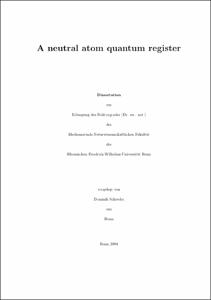A neutral atom quantum register

A neutral atom quantum register

| dc.contributor.advisor | Meschede, Dieter | |
| dc.contributor.author | Schrader, Dominik | |
| dc.date.accessioned | 2020-04-06T23:21:37Z | |
| dc.date.available | 2020-04-06T23:21:37Z | |
| dc.date.issued | 2005 | |
| dc.identifier.uri | https://hdl.handle.net/20.500.11811/2129 | |
| dc.description.abstract | In this thesis I present the realization of a quantum register of single neutral atoms, which is a building block of a quantum computer. It consists of a well known number of "qubits" - the quantum analogs of classical bits - that can be individually addressed and coherently manipulated. Here, a string of single cesium atoms trapped in the potential wells of a standing wave optical dipole trap serves as quantum register. The quantum information is encoded into the hyperfine states of the atoms which are coherently manipulated using microwave radiation. Chapter 1 is devoted to the presentation of a number of tools to control all degrees of freedom of single neutral atoms. A magneto-optical trap provides an exactly known number of cold atoms which are transferred into an optical dipole trap. A photon-counting CCD camera along with molasses cooling allow us to continuously observe the trapped atoms including their controlled transport along the trap axis using our optical "conveyor belt". Finally, I present techniques to initialize, coherently manipulate and measure the hyperfine states of individual atoms with high efficiency. The experimental realization of the quantum register is the focus of Chapter 2, where I describe its working principle and fully characterize its properties. Write and read operations on the quantum register are performed by position-selective coherent manipulation of atom qubits and state-selective measurements. For this purpose, an image is acquired to determine the positions of all trapped atoms. A magnetic field gradient is applied along the trap axis so that individual atom qubits are addressed by tuning the frequency of the microwave radiation to the respective Zeeman-shifted atomic resonance frequency. This addressing scheme operates with a spatial resolution of 2.5µm and qubit rotations on individual atoms are performed with 99% contrast including all experimental imperfections. In a final read-out operation each individual atomic state is analyzed. I finally investigate the coherence properties of the quantum register in detail and identify the mechanisms that lead to decoherence. | en |
| dc.description.abstract | Ein Quantenregister aus neutralen Atomen Gegenstand dieser Arbeit ist die Realisierung eines Quantenregisters aus einzelnen neutralen Atomen, welches einen zentralen Baustein eines Quantencomputers bildet. Ein Quantenregister besteht aus einer wohldefinierten Anzahl von "Qubits" - den quantenmechanischen Analoga von Bits - die individuell adressiert und kohärent manipuliert werden können. Die Qubits werden in dieser Arbeit mit einzelnen Cäsiumatomen realisiert, die in den Potentialtöpfen einer optischen Dipolfalle in Stehwellen-Konfiguration gefangen sind. Die Quanteninformation ist in den Hyperfein-Zuständen der Atome kodiert, die mit Hilfe von Mikrowellenstrahlung kohärent manipuliert werden. In Kapitel 1 stelle ich eine Reihe von Werkzeugen vor, um sämtliche Freiheitsgrade einzelner neutraler Atome zu kontrollieren. Eine magneto-optische Falle dient als Quelle einer genau bestimmten Anzahl von kalten Atomen, die dann in eine optische Dipolfalle umgeladen werden. Mit Hilfe von Melasse-Kühlverfahren und einer photonenzählenden CCD-Kamera können wir die gespeicherten Atome und sogar deren kontrollierten Transport kontinuierlich beobachten. Schließlich beschreibe ich die Techniken, mit denen wir die Hyperfeinzustände einzelner Atome mit hoher Effizienz präparieren, kohärent manipulieren und messen. Die experimentelle Realisierung des Quantenregisters steht im Zentrum von Kapitel 2. Ich beschreibe sein Funktionsprinzip und charakterisiere seine Eigenschaften umfassend. Die einzelnen Qubits des Registers werden mit Hilfe von positionsselektiver kohärenter Manipulation beschrieben und analysiert. Zu diesem Zweck bestimmen wir zunächst die Positionen aller gespeicherten Atome, indem wir ein Bild der Atomkette auswerten. In einem Magnetfeldgradienten adressieren wir dann einzelne Atome mit Mikrowellenstrahlung, indem wir die Mikrowellenfrequenz auf die Zeeman-verschobene Resonanzfrequenz des entsprechenden Atoms abstimmen. Die räumliche Auflösung dieser Adressiertechnik beträgt 2,5µm. Sie ermöglicht uns, Qubit-Rotationen auf einzelnen Atomen mit einem Kontrast von 99% durchzuführen, einschließlich aller experimentellen Imperfektionen. Zum Schluss untersuche ich detailliert die Kohärenzeigenschaften des Quantenregisters und identifiziere die Dekohärenzmechanismen. | en |
| dc.language.iso | eng | |
| dc.rights | In Copyright | |
| dc.rights.uri | http://rightsstatements.org/vocab/InC/1.0/ | |
| dc.subject | Quantencomputer | |
| dc.subject | Manipulation von Atomen | |
| dc.subject | Laserkühlung | |
| dc.subject | Quantenoptik | |
| dc.subject | mechanischer Einfluss von Licht auf Atome | |
| dc.subject | kohärente Kontrolle von atomarer Wechselwirkung mit Photonen | |
| dc.subject | quantum computation | |
| dc.subject | atom manipulation | |
| dc.subject | laser cooling | |
| dc.subject | quantum optics | |
| dc.subject | mechanical effects of light on atoms | |
| dc.subject | coherent control of atomic interactions with photons | |
| dc.subject.ddc | 530 Physik | |
| dc.title | A neutral atom quantum register | |
| dc.type | Dissertation oder Habilitation | |
| dc.publisher.name | Universitäts- und Landesbibliothek Bonn | |
| dc.publisher.location | Bonn | |
| dc.rights.accessRights | openAccess | |
| dc.identifier.urn | https://nbn-resolving.org/urn:nbn:de:hbz:5N-04870 | |
| ulbbn.pubtype | Erstveröffentlichung | |
| ulbbnediss.affiliation.name | Rheinische Friedrich-Wilhelms-Universität Bonn | |
| ulbbnediss.affiliation.location | Bonn | |
| ulbbnediss.thesis.level | Dissertation | |
| ulbbnediss.dissID | 487 | |
| ulbbnediss.date.accepted | 16.12.2004 | |
| ulbbnediss.fakultaet | Mathematisch-Naturwissenschaftliche Fakultät | |
| dc.contributor.coReferee | Buse, Karsten |
Dateien zu dieser Ressource
Das Dokument erscheint in:
-
E-Dissertationen (4390)




